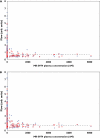Inhibition of capsaicin-induced increase in dermal blood flow by the oral CGRP receptor antagonist, telcagepant (MK-0974)
- PMID: 20078608
- PMCID: PMC2830593
- DOI: 10.1111/j.1365-2125.2009.03543.x
Inhibition of capsaicin-induced increase in dermal blood flow by the oral CGRP receptor antagonist, telcagepant (MK-0974)
Abstract
What is already known about this subject: * Calcitonin gene-related peptide (CGRP) was first described as a potent vasodilator. * CGRP is also increasingly recognized as a key player in the pathophysiology of migraine, and CGRP receptor antagonists potentially offer a new approach for treating migraine. * A novel pharmacodynamic assay to measure CGRP receptor antagonist activity non-invasively in humans has been developed, which involves measuring the increase in dermal blood flow induced by topical application of capsaicin on the forearm.
What this study adds: * This study shows that the novel oral CGRP receptor antagonist, telcagepant, inhibits the increases in dermal blood flow induced by the topical application of capsaicin on the human forearm. * This experimental medicine model may have utility to assist in dose selection for the development of CGRP receptor antagonists.
Aims: To evaluate inhibition of capsaicin-induced increase in dermal blood flow (DBF) following telcagepant (MK-0974), a potent and selective orally bioavailable calcitonin gene-related peptide (CGRP) receptor antagonist being developed for the acute treatment of migraine.
Methods: A three-period crossover study in 12 healthy adult men. Each subject received a single oral dose of telcagepant 300 mg, telcagepant 800 mg or placebo at 0 h, followed 0.5 and 3.5 h later by two topical doses of 300 and 1000 microg capsaicin per 20 microl water-ethanol mixture. Capsaicin was applied at two sites on the volar surface of the subjects' left and right forearms. DBF was assessed by laser Doppler perfusion imaging immediately before ('baseline'), and 0.5 h after each capsaicin application at 1 and 4 h. Plasma samples to determine telcagepant concentrations were collected immediately after laser Doppler perfusion imaging. A pharmacodynamic model was developed to explore the relationship between plasma concentration and inhibition of capsaicin-induced increase in DBF.
Results: Geometric mean plasma concentrations after dosing with 300 mg and 800 mg telcagepant were 720 and 1146 nm, respectively, at 1 h, vs. 582 and 2548 nm, respectively, at 4 h. The pharmacodynamic model suggested that the EC(90) for telcagepant inhibition of capsaicin-induced increases in DBF was 909 nm.
Conclusions: Telcagepant inhibits the increases in DBF induced by the topical application of capsaicin on the human forearm. This experimental medicine model may have utility to assist in dose selection for the development of CGRP receptor antagonists.
Figures


Similar articles
-
Characterizing the PK/PD relationship for inhibition of capsaicin-induced dermal vasodilatation by MK-3207, an oral calcitonin gene related peptide receptor antagonist.Br J Clin Pharmacol. 2015 May;79(5):831-7. doi: 10.1111/bcp.12547. Br J Clin Pharmacol. 2015. PMID: 25377933 Free PMC article. Clinical Trial.
-
Pharmacological characterization of MK-0974 [N-[(3R,6S)-6-(2,3-difluorophenyl)-2-oxo-1-(2,2,2-trifluoroethyl)azepan-3-yl]-4-(2-oxo-2,3-dihydro-1H-imidazo[4,5-b]pyridin-1-yl)piperidine-1-carboxamide], a potent and orally active calcitonin gene-related peptide receptor antagonist for the treatment of migraine.J Pharmacol Exp Ther. 2008 Feb;324(2):416-21. doi: 10.1124/jpet.107.130344. Epub 2007 Nov 26. J Pharmacol Exp Ther. 2008. PMID: 18039958
-
Calcitonin gene-related peptide8-37 antagonizes capsaicin-induced vasodilation in the skin: evaluation of a human in vivo pharmacodynamic model.J Pharmacol Exp Ther. 2008 Apr;325(1):248-55. doi: 10.1124/jpet.107.133868. Epub 2008 Jan 23. J Pharmacol Exp Ther. 2008. PMID: 18216286 Clinical Trial.
-
Possible site of action of CGRP antagonists in migraine.Cephalalgia. 2011 Apr;31(6):748-50. doi: 10.1177/0333102411398403. Epub 2011 Mar 7. Cephalalgia. 2011. PMID: 21383046 Review.
-
ACS chemical neuroscience molecule spotlight on Telcagepant (MK-0974).ACS Chem Neurosci. 2011 Jul 20;2(7):334-5. doi: 10.1021/cn200059f. ACS Chem Neurosci. 2011. PMID: 22816019 Free PMC article. Review.
Cited by
-
Antiseizure Medications for the Prophylaxis of Migraine during the Anti- CGRP Drugs Era.Curr Neuropharmacol. 2023;21(8):1767-1785. doi: 10.2174/1570159X21666221228095256. Curr Neuropharmacol. 2023. PMID: 36582062 Free PMC article. Review.
-
Roles of calcitonin gene-related peptide in the skin, and other physiological and pathophysiological functions.Brain Behav Immun Health. 2021 Oct 5;18:100361. doi: 10.1016/j.bbih.2021.100361. eCollection 2021 Dec. Brain Behav Immun Health. 2021. PMID: 34746878 Free PMC article. Review.
-
Antidromic vasodilatation and the migraine mechanism.J Headache Pain. 2012 Mar;13(2):103-11. doi: 10.1007/s10194-011-0408-3. Epub 2011 Dec 27. J Headache Pain. 2012. PMID: 22200764 Free PMC article. Review.
-
Tachykinins and their receptors: contributions to physiological control and the mechanisms of disease.Physiol Rev. 2014 Jan;94(1):265-301. doi: 10.1152/physrev.00031.2013. Physiol Rev. 2014. PMID: 24382888 Free PMC article. Review.
-
The role of erenumab in the treatment of migraine.Ther Adv Neurol Disord. 2020 May 27;13:1756286420927119. doi: 10.1177/1756286420927119. eCollection 2020. Ther Adv Neurol Disord. 2020. PMID: 32523630 Free PMC article. Review.
References
-
- Evans RM, Amara S, Rosenfield MG. Molecular events in developmental regulation of neuroendocrine genes: characterization of the novel neuropeptide CGRP. Cold Spring Harb Symp Quant Biol. 1983;48:413–7. - PubMed
-
- Brain SD, Williams TJ, Tippins JR, Morris HR, MacIntyre I. Calcitonin gene-related peptide is a potent vasodilator. Nature. 1985;313:54–6. - PubMed
-
- Edvinsson L, Fredholm BB, Hamel E, Jansen I, Verrecchia C. Perivascular peptides relax cerebral arteries concomitant with stimulation of cyclic adenosine monophosphate accumulation or release of an endothelium-derived relaxing factor in the cat. Neurosci Lett. 1985;58:213–7. - PubMed
-
- Uddman R, Edvinsson L, Ekblad E, Håkanson R, Sundler F. Calcitonin gene-related peptide (CGRP): perivascular distribution and vasodilatory effects. Regul Pept. 1986;15:1–23. - PubMed
-
- de Hoon JN, Pickkers P, Smits P, Struijker-Boudier HA, Van Bortel LM. Calcitonin gene-related peptide: exploring its vasodilating mechanism of action in humans. Clin Pharmacol Ther. 2003;73:312–21. - PubMed
Publication types
MeSH terms
Substances
LinkOut - more resources
Full Text Sources
Other Literature Sources
Research Materials

